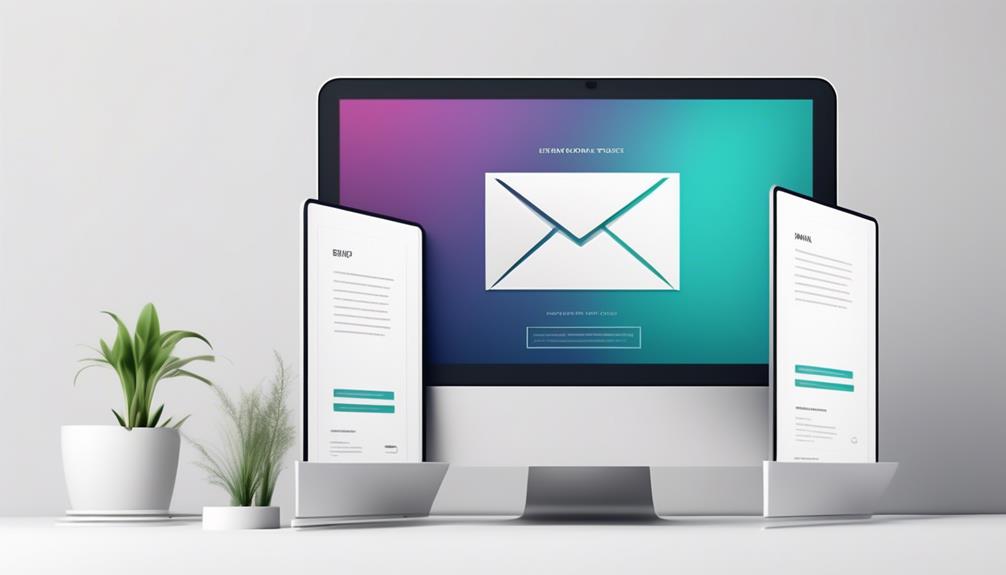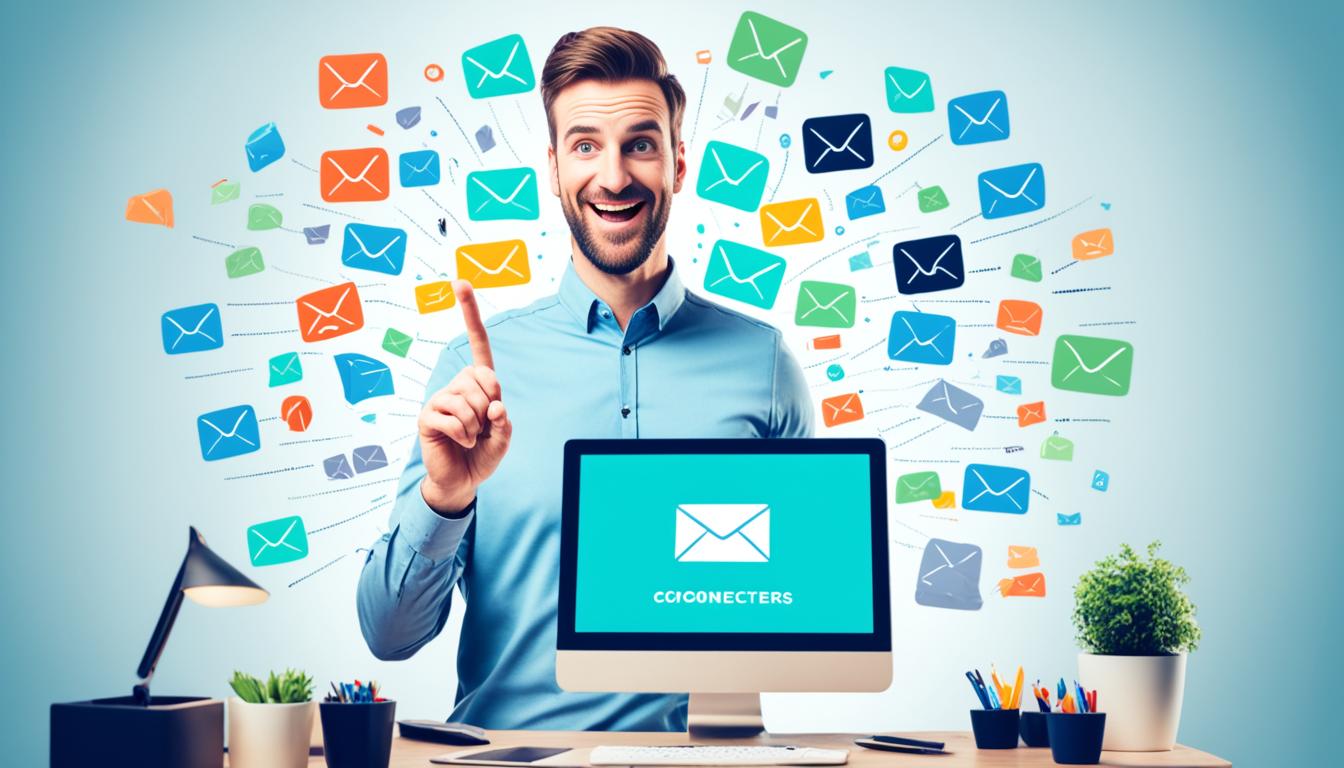Email marketing is a versatile tool that can be used as either an inbound or outbound strategy, depending on the goals of the campaign. Understanding the distinctions between these methods is crucial in creating an effective email marketing strategy.
While some may argue that it's a clear-cut case, the truth is, the lines can often blur. So, how do we determine whether email marketing belongs in the inbound or outbound category?
Let's explore the nuances and practical implications of each approach to gain a deeper understanding of how email marketing fits into the broader spectrum of marketing strategies.
Key Takeaways
- Inbound email marketing focuses on nurturing consumer interest and building brand trust through tailored content.
- Outbound email marketing requires a strategic and targeted approach to directly connect with potential customers and yield impressive results.
- Audience engagement in email marketing can be enhanced through segmentation, personalization, and two-way communication.
- Balancing the reach and speed advantages of inbound and outbound strategies can optimize email marketing efforts.
Defining Email Marketing
Email marketing effectively nurtures initial consumer interest and drives brand awareness through relevant and engaging content. By leveraging the power of inbound email marketing, we can attract and engage our audience with tailored, valuable content that speaks directly to their needs and interests. This targeted approach not only increases opt-ins and brand trust but also saves money by maximizing return on investment (ROI) through personalized communication.
Inbound email marketing is a strategic tool for nurturing consumer interest and building brand awareness organically. By delivering valuable content directly to our customers' inboxes, we can establish our brand as a trusted source of information and solutions. This approach is particularly effective for products and services with longer sales cycles, as it requires a long-term commitment to engaging and nurturing our audience.
Inbound Marketing Overview

Inbound marketing is a critical component of any successful email marketing strategy. By focusing on providing valuable and relevant content to consumers, we can nurture their interest and drive brand awareness organically.
This approach not only saves money and maximizes ROI but also fosters a sense of trust and loyalty with our audience, setting the stage for long-term success.
Inbound Marketing Principles
Utilizing a customer-centric approach, inbound marketing principles focus on nurturing consumer interest through relevant and engaging content, ultimately attracting consumers to products and services while building brand trust and loyalty.
Inbound email marketing strategies aim to provide valuable content that resonates with the target audience, leading to increased lead generation and improved engagement. By creating content that addresses the needs and pain points of potential customers, businesses can reach their potential audience more effectively.
This approach not only saves money by tailoring marketing efforts to consumer interest but also maximizes return on investment (ROI) by driving organic brand awareness and loyalty.
Inbound marketing principles are particularly effective for products and services with longer sales cycles, requiring a long-term commitment to building relationships and delivering valuable content.
Email as Inbound Strategy
Drawing consumers in with valuable and relevant content, inbound email marketing strategically nurtures initial interest and engagement with your brand. This approach provides tailored content to attract and retain potential customers, increasing brand trust and loyalty.
Additionally, inbound email marketing saves costs by focusing on consumer interests, maximizing return on investment. By nurturing a loyal and engaged audience over time, it drives organic brand awareness and growth.
In contrast to outbound email marketing, which often incurs higher costs and can be seen as intrusive, inbound email marketing increases opt-ins and protects the reputation of your IP address.
Leveraging the capabilities of email marketing platforms, inbound email strategies capitalize on delivering the right content to the right audience, at the right time, for maximum impact.
Outbound Marketing Overview
When implementing outbound email marketing, a strategic and targeted approach is essential to effectively reach potential customers and drive results. Outbound email marketing serves as a direct marketing channel, allowing businesses to rapidly reach and engage with target audiences. By leveraging the speed of outbound email, companies can promptly connect with potential customers, delivering messages on their own schedule.
Although outbound marketing may carry the risk of appearing as spam, careful management and adherence to best practices can mitigate this concern. This proactive approach to reaching potential customers doesn't require consent, as emails are sent based on an ideal customer profile. When executed well, outbound email campaigns can yield impressive results, with open rates averaging at 16.07% and click-through rates at 3.29%. These statistics underscore the potential of effective email outreach in driving customer engagement and conversions.
Therefore, when considering outbound marketing strategies, it's crucial to craft compelling, targeted messages that resonate with the intended audience to maximize the impact of each campaign.
Email Marketing Strategies

Crafting compelling email marketing strategies is crucial for businesses to effectively reach potential customers and drive results, especially considering the potential impact of outbound email campaigns on customer engagement and conversions.
Here are three key strategies to consider:
- Personalization: Tailoring emails based on consumer interests and behaviors can significantly increase engagement and conversion rates. Using data to personalize content and offers can make the recipient feel valued and understood, leading to higher sales potential.
- Automation: Implementing automated email workflows can streamline the nurturing process, ensuring that leads are consistently engaged with relevant content. This strategy can help businesses save time and resources while maintaining a consistent presence in the consumer's journey.
- Segmentation: Dividing the email list into different segments based on demographics, behaviors, or past interactions allows for targeted and relevant communication. By sending content that aligns with the recipient's interests, businesses can improve the chances of driving sales and increasing customer satisfaction.
Key Differences
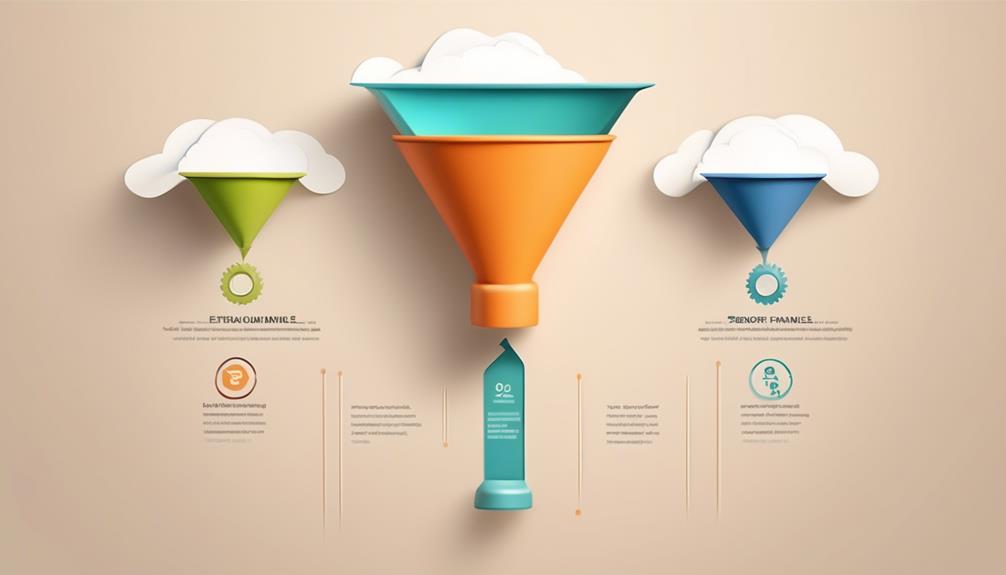
To understand the distinction between inbound and outbound email marketing, it's essential to recognize their fundamental disparities in approach and impact.
Inbound email marketing focuses on attracting interested consumers through personalized, tailored content. It involves two-way communication, building a loyal audience over time through engagement.
In contrast, outbound email marketing pushes emails to a wider audience, often using non-personalized, mass-mailed content. It's a one-way communication strategy that aims for immediate results.
The key difference lies in the audience's interest and engagement level. Inbound marketing targets a smaller, more engaged audience, fostering long-term loyalty, while outbound marketing emails target a larger but less interested audience, resulting in immediate, albeit potentially less enduring, outcomes.
Moreover, inbound email marketing involves building and nurturing email lists organically, often through content offerings and opt-ins, ensuring that the audience has a genuine interest in the content they receive.
On the other hand, outbound email marketing often involves purchased or rented email lists, leading to a less targeted and less engaged audience.
Understanding these differences is crucial in crafting effective email marketing strategies that align with business goals and audience preferences.
Audience Engagement

Understanding the pivotal role of audience engagement in email marketing, we can now explore strategies to foster meaningful interactions and drive impactful results.
- Personalized Content: Tailoring email content to the preferences and behaviors of the audience is crucial. Utilizing segmentation and personalization techniques can significantly enhance audience engagement. By crafting content that resonates with the target audience, we can encourage interaction and increase the likelihood of meaningful engagement.
- Encouraging Interaction: It's essential to encourage feedback, replies, and social media sharing to gauge and improve audience engagement with email content. Creating opportunities for two-way communication can strengthen the connection between the brand and the audience, leading to increased engagement and brand loyalty.
- Monitoring and Optimization: Regularly monitoring metrics such as open rates, click-through rates, and conversion rates provides insights into the effectiveness of audience engagement strategies. This data-driven approach allows for continual optimization of email content and strategies to maximize engagement and drive impactful results.
Reach and Speed

When it comes to email marketing, reach and speed are crucial for expanding our audience and delivering messages swiftly.
By rapidly growing our email list and effectively distributing messages, we can efficiently extend our marketing reach and promptly engage with a broader audience through email communications.
Achieving a wider reach and delivering messages at a faster pace are essential for connecting with a larger audience and ensuring prompt delivery of marketing messages through email.
Email Reach Advantage
Email marketing's reach advantage and speed are critical factors in determining the effectiveness of both inbound and outbound strategies.
- Inbound Email Marketing: It takes time to attract an interested audience and build a loyal subscriber base, leading to a higher ROI over months or years.
- Outbound Email Marketing: Reaches a larger audience more quickly, expediting message delivery to potential customers.
- Cost-Effectiveness: Inbound marketing targets warm leads and personalized content for a smaller list, making it cost-effective with higher ROI. Outbound marketing involves higher costs due to larger contact lists and email volumes, resulting in lower ROI.
Email marketing's reach advantage can be leveraged by choosing the right email service provider, ensuring effective message delivery and maximizing the potential of both inbound and outbound strategies.
Email Speed Benefits
Leveraging the reach advantage of email marketing, we can now explore the impactful speed benefits of both inbound and outbound strategies.
Outbound email marketing targets a wider audience in a shorter period, making it ideal for industries with shorter sales cycles. This approach can lead to quicker results but may also incur increased costs.
On the other hand, inbound email marketing, while taking more time to attract an interested audience, has lower costs and a higher return on investment with targeted warm leads from existing subscribers.
Understanding the email speed benefits of both inbound and outbound strategies is crucial for optimizing marketing efforts. By strategically balancing the speed and reach advantages of each approach, businesses can effectively engage with their audience and achieve their marketing goals.
Inbound Vs Outbound Emails
To effectively compare inbound and outbound emails, we must consider their respective reach and speed to determine the most strategic approach for our email marketing efforts.
- Reach: Inbound emails attract an interested audience over time, nurturing a loyal following. On the other hand, outbound emails reach a wider audience more quickly, generating immediate results.
- Speed: Outbound emails have a quicker impact, making them suitable for short-term campaigns. In contrast, inbound emails take time to build an interested audience but are 61% cheaper than outbound emails.
Considering these factors, a balanced approach is crucial. Utilize outbound emails for immediate reach and impact, while investing in inbound email marketing to build a loyal and engaged audience over time.
Cost Analysis

In conducting a comprehensive cost analysis, businesses gain vital insights into the financial efficiency and impact of their marketing strategies and operations.
When it comes to email marketing, both inbound and outbound emails incur costs that need to be carefully evaluated. The cost analysis of inbound email marketing involves assessing expenses related to creating valuable content, designing engaging templates, and implementing automation tools.
On the other hand, outbound email marketing entails costs associated with building and maintaining email lists, crafting persuasive copy, and employing delivery and tracking systems.
Understanding the cost dynamics of inbound and outbound email marketing is crucial for optimizing budget allocation and maximizing return on investment (ROI). By analyzing the costs involved in each approach, businesses can make informed decisions about resource allocation, identifying areas for cost savings, and optimizing their marketing strategies.
Furthermore, cost analysis provides insights into the ROI of different email marketing initiatives, enabling businesses to prioritize activities that yield the highest returns. Ultimately, a thorough cost analysis empowers businesses to allocate their marketing resources strategically, ensuring that their email marketing efforts aren't only effective but also cost-efficient.
Inbound Email Examples
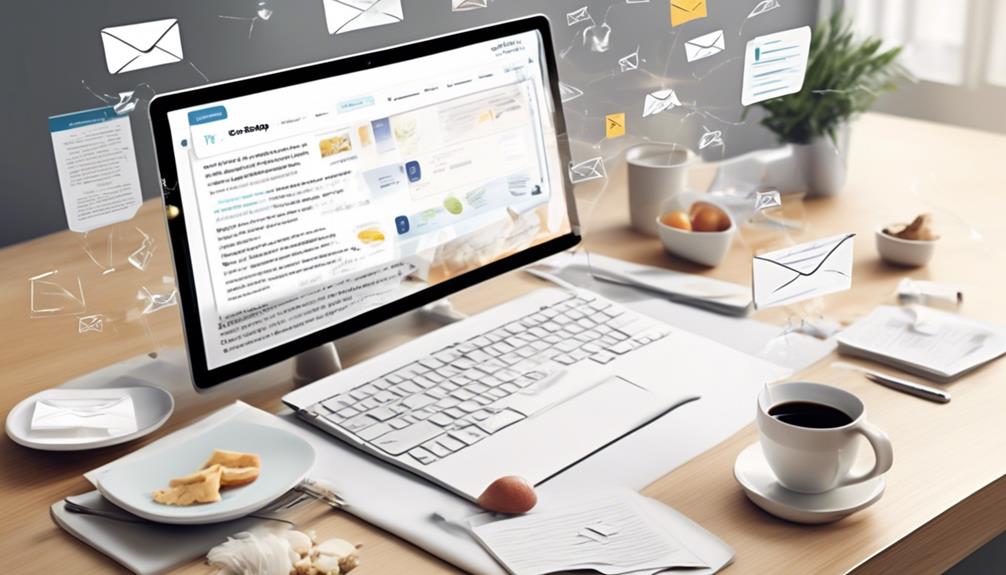
When implementing inbound email marketing, businesses can effectively engage consumers by delivering relevant and tailored content directly to their inboxes. This approach aligns with the interests and preferences of the recipients, making it more likely for them to engage with the brand.
Here are three examples of inbound email marketing:
- Newsletters: These emails provide subscribers with valuable information, updates, and insights related to the brand's products or industry. By offering meaningful content, newsletters keep the brand top-of-mind and nurture long-term relationships with the audience.
- Welcome Emails: These are sent to new subscribers or customers, expressing appreciation for their interest and providing them with useful information about the brand, its products, and how to get the most out of their experience. Welcome emails set the tone for a positive brand interaction and can significantly impact the recipient's perception.
- Promotional Emails: While still being promotional, these emails are tailored to the specific interests of the recipients. By leveraging data and analytics, businesses can send targeted promotions to individuals who've shown a genuine interest in their products or services, increasing the likelihood of conversion.
Inbound email marketing allows businesses to establish meaningful connections with people genuinely interested in their brand, fostering brand loyalty and driving sustainable growth.
Outbound Email Examples
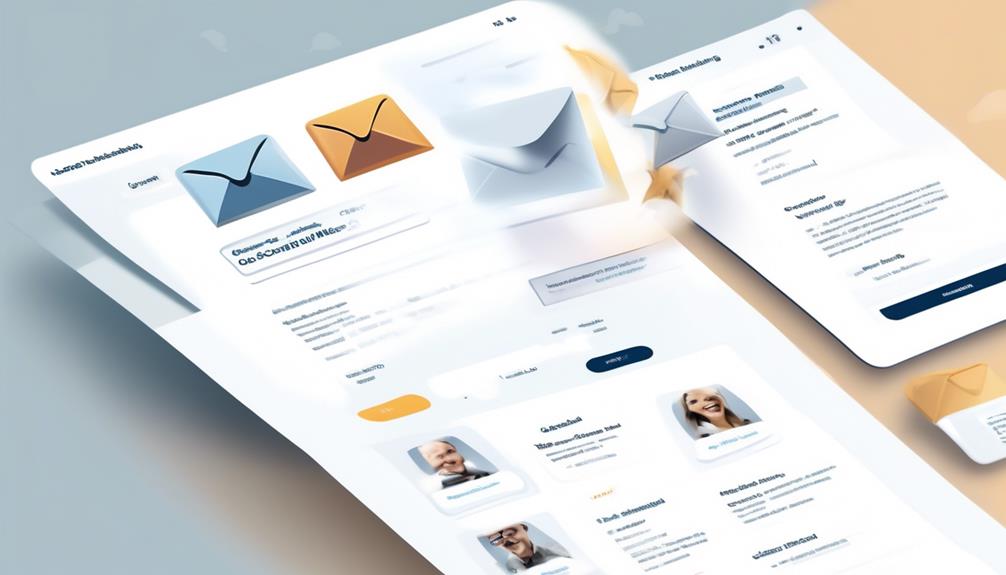
Outbound email examples are a crucial aspect of any marketing strategy. Understanding the purpose and strategy behind outbound emails can greatly impact their effectiveness.
Outbound Email Purpose
To effectively illustrate the purpose and impact of outbound email marketing, consider the example of a personalized email campaign tailored to recent events that resulted in a significant increase in customer engagement and conversions.
- Promotional Reach: Outbound emails serve as a strategic tool for spreading brand awareness and promoting products or services to a broader audience.
- Engagement and Conversion: They aim to spark interest and trigger positive emotions, leading to increased customer engagement and higher conversion rates.
- Cold Outreach: Outbound email marketing strategies involve reaching out to potential leads through personalized and targeted cold emails based on an ideal customer profile.
Outbound Email Strategy
Building on the impactful potential of personalized outbound email campaigns, let's now explore specific examples that demonstrate successful outbound email strategies in action.
A well-crafted outbound email strategy can yield impressive results, with open rates averaging 16.07% and click-through rates reaching 3.29%. Techniques such as AIDA, PAS, BAB, and PPP cold emails can be effectively utilized in outbound email marketing.
While there are costs associated with outbound email marketing, including email service provider fees, tool subscriptions, and content creation, these investments can be justified by the potential for reaching a wider audience.
Building and maintaining targeted contact lists is crucial for sending outbound emails to the right recipients.
Real Business Case Studies
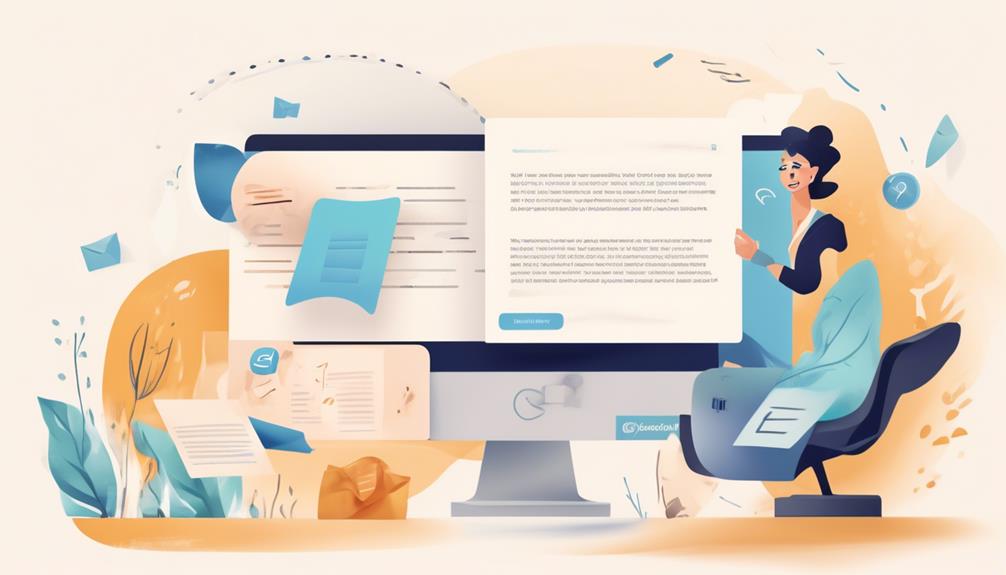
Real Business Case Studies offer invaluable insights into successful business strategies and tactics implemented by various companies, providing practical, real-world examples of business challenges and solutions. These case studies cover a wide range of industries, offering diverse perspectives and learnings. They provide actionable takeaways for business professionals, serving as a platform for learning from the experiences of other businesses and aiding in decision-making and strategy development.
- Diverse Industry Perspectives: Case studies encompass a wide array of industries, including technology, retail, finance, and healthcare, offering insights applicable to different business sectors.
- Practical Solutions and Strategies: Real-world examples showcase how companies effectively utilize inbound and outbound email marketing campaigns, including abandoned cart emails, to drive customer engagement and sales.
- Decision-Making Support: Business case studies provide valuable data and analysis, aiding professionals in making informed decisions regarding their inbound and outbound email marketing strategies.
Real Business Case Studies present an opportunity to delve into the practical applications of inbound and outbound email marketing, providing actionable insights that can be leveraged to enhance email marketing campaigns and achieve business objectives.
Integrating Email Marketing

As we explore 'Integrating Email Marketing', we can draw practical insights from real business case studies to understand how companies effectively incorporate email marketing into their inbound and outbound strategies to drive customer engagement and achieve business objectives.
Integrating email marketing into the inbound strategy involves nurturing initial consumer interest and providing relevant content to attract them to products and services. This approach increases opt-ins, protects IP address reputation, and tailors marketing to consumer interest, ultimately driving organic brand awareness, building trust, and loyalty. It also includes offering valuable content like blogs, webinars, and newsletters.
On the other hand, integrating email marketing into the outbound strategy allows for reaching a wider audience and expediting results by getting messages to potential customers on a set schedule. It enables strategic targeting of specific audiences while managing costs and avoiding the risk of appearing as spam.
Adding Outbound Strategy

Implementing an outbound email strategy can significantly expand the reach of your marketing efforts and accelerate engagement with potential customers. There are several key reasons why adding an outbound strategy to your email marketing approach can be beneficial:
- Broader Audience Reach: Outbound email marketing allows you to target a wider audience, including individuals who may not have interacted with your brand through inbound channels. This presents an opportunity to build a larger base of potential customers who may be interested in your products and services.
- Expedited Results: Unlike inbound email marketing, which relies on customers initiating contact, outbound strategies enable you to proactively reach out to potential leads. This can expedite the process of generating interest and conversions, allowing you to control the timing of your outreach efforts.
- Enhanced Visibility: By utilizing outbound email marketing, you can increase the visibility of your brand and offerings to a broader audience. This can help spark initial interest and awareness, potentially leading to new customer acquisitions.
Incorporating an outbound email strategy into your overall marketing approach can complement your existing inbound efforts, ultimately contributing to a more comprehensive and effective outreach strategy.
Additional Resources
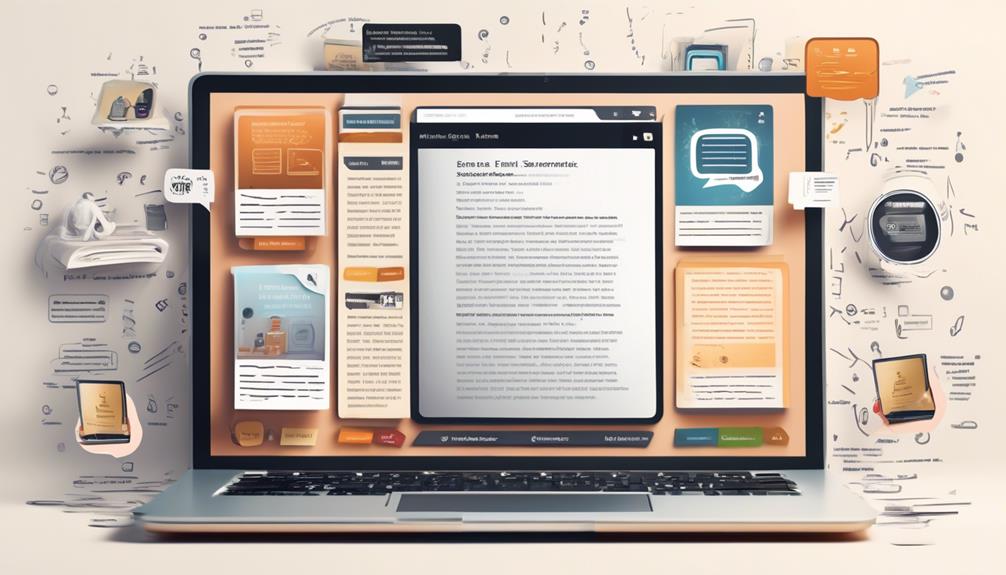
As we continue to explore the intricacies of email marketing, it's imperative to leverage additional resources to elevate our strategies.
These resources offer valuable insights and best practices for enhancing email engagement and conversion rates.
Email Types
How do different email types contribute to the effectiveness of inbound and outbound marketing strategies?
- Welcome emails: These are crucial for inbound marketing as they can nurture initial consumer interest through relevant content and tailored experiences, increasing opt-ins and driving brand awareness organically.
- Cold calls: Typically associated with outbound marketing, cold calls refer to reaching out to potential customers who didn't request the email. While this approach reaches a wider audience, it can be costly and risks appearing as spam.
- Targeted emails to people who've shown interest: These are effective for both inbound and outbound marketing. Inbound email marketing nurtures consumer interest through tailored experiences, while outbound email marketing targets a wider audience and can help reach a wider audience. However, it may be less effective in turning recipients into customers compared to inbound marketing.
Marketing Strategies
Considering the significant impact of different email types on inbound and outbound marketing effectiveness, exploring additional resources for optimizing marketing strategies becomes imperative. When devising a comprehensive marketing approach, it's crucial to consider the integration of email with other channels like social media marketing. Utilizing the AIDA formula (Attention, Interest, Desire, Action) can enhance the effectiveness of outbound email campaigns by guiding recipients through the stages of making a purchase decision. Inbound email marketing can be further optimized by leveraging personalized messages that resonate with the audience's needs and interests. To provide a clear overview, here's a comparison table showcasing the key differences between inbound and outbound email marketing:
| Aspect | Inbound Email Marketing | Outbound Email Marketing |
|---|---|---|
| Target Audience | Warmed-up contacts | Wider audience |
| Cost-effectiveness | Higher ROI due to engaged audience | Effective when used properly |
| Approach | Nurtures captive audience over time | Reaches entire audience, encourages engagement |
| Techniques | Tailored experiences, valuable content | AIDA formula, personalized messages |
Is Email Marketing in Hindi also categorized as Inbound or Outbound?
Yes, email marketing in Hindi can be categorized as both inbound and outbound. In inbound marketing, emails are sent to engage with existing customers, while in outbound marketing, emails are used to reach out to potential customers. Both can be effective strategies for targeting Hindi-speaking audiences.
Frequently Asked Questions
Is Email Marketing Considered Inbound or Outbound?
Email marketing is a powerful tool for engaging with our audience and driving brand awareness. It allows us to tailor our messaging to consumer interests, saving money and increasing opt-ins.
What Is an Outbound Email Marketing?
Outbound email marketing involves proactively reaching out to potential customers who haven't opted in. It's a strategic approach to target specific audiences and drive quick results on our schedule.
While it can expedite messaging to a wider audience, it risks being perceived as spam and can be costly. Successful outbound email campaigns can achieve open rates of 16.07% and click-through rates of 3.29%, making it a powerful but challenging tactic to master.
What Type of Marketing Is Email Marketing?
Email marketing encompasses both inbound and outbound strategies. Our approach is to tailor the content and engagement to the audience's level of familiarity with our brand.
We prioritize nurturing existing interest and building loyalty through valuable content and tailored experiences. This data-driven strategy helps us attract and engage a loyal audience.
What Is Email Inbound and Outbound?
Inbound email marketing focuses on nurturing consumer interest with valuable content, driving brand trust and loyalty. It increases opt-ins, protects IP reputation, and tailors marketing to consumer interests.
On the other hand, outbound email marketing involves sending advertising to a broad audience, risking appearing as spam. Inbound marketing pulls in interested consumers, produces results over time, and garners a more loyal audience through engagement, while outbound marketing targets a wider audience, produces immediate results, and often leads to more unsubscribers.
Conclusion
In conclusion, whether email marketing is inbound or outbound really depends on your perspective. But let's be real, we all know it's just a fancy way of saying 'spam' or 'valuable content.'
So why not just focus on creating valuable, relevant content that people actually want to engage with? It's not rocket science, it's just good marketing.
Let's leave the spam in the can where it belongs.





